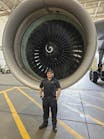There’s one catering truck out of some 200 high-lift vehicles that drivers from the Flying Food Group operate with a bit more care.
“We tell them that they should drive it like their grandmother would – if, of course, she drove a catering truck with a scissors lift out on the ramp,” says Greg Brown, vice president of procurement for the Chicago-based caterer.
That’s because every time a driver steps on the brake in the company’s newest vehicle a regenerative braking system provides the power to raise the lift.
There’s much more to the drivers training than advice to act like Grandma, but slow and steady is what wins this race.
“You don’t just hop in the driver’s seat, turn the key and take off,” Brown says. “We had plenty of training to operate the vehicle since there are specific procedures to follow to make this truck work its best.”
Such a braking system sounds counter-intuitive at first. Brakes stop power; they don’t create power. Or do they? We think the best advice to think about this is to keep an eye on the “re” in “regeneration.” When those two letters are fixed before a word, it means both “backward” and “again.”
Typically, we all slam on the brakes in our car and that energy of slowing and stopping a 2,000-pound vehicle is wasted as friction turns that energy into heat, which does a number on your brake pads before dissipating in the air.
REUSING ENERGY
With a regenerative braking system, we’re going backward and using the energy again. And, of course, considering a catering truck weighs many times more than a car, we’re starting out with that much more energy.
To create the system, the truck’s engine is about the only thing under the hood that isn’t a part of Eaton’s patented electric hybrid system. The engine is coupled with Eaton’s UltraShift® automated manual transmission and clutch.
Between the output side of the clutch and the transmission, an integrated electic motor/generator is connected to a power inverter and lithium ion batteries, all controlled by an electronic control module.
This parallel hybrid maintains the truck’s traditional drivetrain layout, but uses controls to blend engine torque with electric torque to move the vehicle. The energy normally lost in braking can also be stored in batteries and provide the power to lift the rear body.
Ideally, Brown says the drivers may be able to operate the truck during delivery service on the ramp with nothing but electricity.
“It’s perfect for us,” Brown says. “We don’t put a lot of miles on these trucks, but we do put a lot of hours on them.”
In particular, it’s the stop-and-go nature of Flying Food Group’s business that makes this system work best. A long-haul truck going down the Interstate at 55 mph, not so much. Ironically, driving like a Grandma, slow, steady and maybe with a lot of stops, is exactly the kind of “power” needed for this hybrid.
NO IDLING
Without the regenerative system, the company’s other catering trucks use the truck’s diesel engine for the power to raise the rear body. While it may not seem like much for each delivery, Brown says a catering truck can idle up to two hours a day.
As a result, the system cuts cost in two ways:
- Diesel use for driving can be cut by 30 percent.
- Diesel use can be cut another 20 percent since the rear body will ideally be powered only by electricity.
Brown says as far as he knows this is only such vehicle of its kinds being used for aircraft catering in the United States. It’s definitely the only one at his company. Flying Food plans to test the new vehicle for six months to better judge reductions in diesel consumption.
“We have excellent records throughout the company to see how the truck does,” he says.
While cutting fuel use is the primary reason the company decided to try the regeneration system, cutting all that idling time may also show a benefit in maintenance costs, too.
“Every business that is out every day conducting business in a large public space like an airport is also interested in ways to reduce carbon emissions,” Brown adds.
At the end of the day, Global’s scissor lift and the rear body supplied on the Navistar engine and chassis doesn’t care how it’s lifted.
Global originally entered the catering and cabin service truck business in 1998. Global manufactures a wide range of scissor-lift trucks to service every type of aircraft from small regional airplanes to large wide-body aircraft. With varying height and width ranges from 89 inches to 228 inches, the body styles include stainless steel, aluminum and fiberglass reinforced plywood. Global's line of aviation catering and cabin service lift trucks is designed with an exclusive scissor-lift along with two single-stage hydraulic lift cylinders.
Since 1998, the company has sold more than 200 units to major airlines and in-flight catering companies across the country and internationally.
Global’s scissor lift and rear body are on many of the Flying Food Group trucks that operate from 18 production kitchens throughout the United States and one in Shanghai, China, delivering $369 million in annual food service to 70 airlines and other retail customers, such as Starbucks.
The company counts some of the best-known international airlines, such Air France, British Airways, JAL and Lufthansa, as customers and produces more than 300,000 meals and snacks daily.
Owner Sue Gin founded the business in Chicago in 1983 to provide passenger meals for a single domestic carrier out of Midway Airport. She later expanded to ORD. Under a decades-long partnership, her company and Air France’s catering arm Servair jointly operate kitchens at five gateway cities in Chicago, Miami, New York, Seattle and San Francisco.




